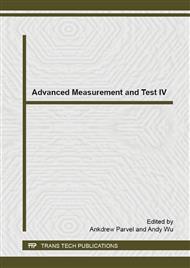[1]
Yin, LJ. Analysis of the Pollution Caused by Raised Dust in City of China. J. Tangshan Teach. Col. 2009, 31(2), 158-160.
Google Scholar
[2]
Sullivan, R. C.; Guazzotti, S. A.; Sodeman, D. A.; Prather, K. A. Direct observations of the atmospheric processing of Asian mineral dust. Atmospheric Chemistry and Physics. 2007, 7(5), 1213-1236.
DOI: 10.5194/acp-7-1213-2007
Google Scholar
[3]
Feng, YW; Chen, J. Exploration on Prevention and Control of Dust Pollution. Energy and Energy Cons. 2011, (4), 40-41, 45.
Google Scholar
[4]
Wen, LL. Numerical Simulation of the Spatial Migration Rule of Fugitive Dusts at Urban Building Construction Sites. Lanzhou University.
Google Scholar
[5]
Zhang, RJ; Wang, MX; Sheng, LF; Kanai, Y; Ohta, A. Seasonal Characterization of Dust Days, Mass Concentration and Dry Deposition of Atmospheric Aerosols over Qingdao, China. China Particuology Sci. and Tech. of Particles. 2004, 2(5), 196-199.
DOI: 10.1016/s1672-2515(07)60058-x
Google Scholar
[6]
Cao, JJ; Lee, SC; Ho, KF; Zou, SC; Zhang, XY; Pan, JG. Spatial and Seasonal Distributions of Atmospheric Carbonaceous Aerosols in Pearl River Delta Region, China. China Particuology Sci. and Tech. of Particles. 2003, 1(1), 33~37.
DOI: 10.1016/s1672-2515(07)60097-9
Google Scholar
[7]
Yuan, CS; Sau, CC; Chen, MC. Influence of Asian Dusts on the Physicochemical Properties of Atmospheric Aerosols in Taiwan District—Using the Penghu Islands as an Example. China Particuology Sci. and Tech. of Particles. 2004, 2(4), 144-152.
DOI: 10.1016/s1672-2515(07)60045-1
Google Scholar
[8]
Carvalhol, MG; Santos, JMRCA; Martins, AA; Figueiredo, MM. The effects of beating, web forming and sizing on the surface energy of Eucalyptus globulus kraft fibres evaluated by inverse gas chromatography. Cellulose. 2005, 12, 371-383.
DOI: 10.1007/s10570-004-7738-0
Google Scholar
[9]
Banerjee, RK. Surface characterization of paper and printability. IPPTA-Indian Pulp & Paper Technical Association Annual General Meeting & Seminar on Developments in Pulp mill and Paper Machine Clothings. 1991, New Delhi.
Google Scholar
[10]
Truong, BY; Shen, W. I Effect of primary fines and surface charge of hardwood pulps on AKD sizing. Appita J. 2003, 56(1), 30–34.
Google Scholar
[11]
Yu,Y. Study on feature of VOCs emission from acrylic interior wall latex paint. New Building Mater. 2009, (7), 69-71.
Google Scholar
[12]
Kriwet, B; Walter, E; Kissel, T. Synthesis of bioadhesive poly (acrylic acid) nano-and microparticles using an inverse emulsion polymerization method for the entrapment ofhydrophilic drug candidates. J. Control. Release. 1998, 56, 149-158.
DOI: 10.1016/s0168-3659(98)00078-9
Google Scholar
[13]
Marschütz, MK; Bernkop-Schnürch, A. Thiolated poly-mers: Self-crosslinking properties of thiolated 450 kDa poly (acrylic acid) and their influence on mucoadhesion. Eur. J. Pharm. Sci. 2002, 15, 387-394.
DOI: 10.1016/s0928-0987(02)00025-8
Google Scholar
[14]
Zhong, YL; Ha, EH. Preparation of Acrylic Resin. In: Acrylic Resin and Application; Li, L; Yan, Y.; Chemical Industry Press, Beijing, 2011; pp.18-69.
Google Scholar
[15]
De, TK; Rodman, DJ; Holm, BA; Prasad, PN; Bergey, EJ; Brimonidine formulation in polyacrylic acid nanopar-ticles for ophthalmic delivery. J. Microencapsul. 2003, 20: 361-374.
DOI: 10.3109/02652040309178075
Google Scholar
[16]
Chen, YC; Zhang, YF; Kuang, JZ. Preparation of Furfural Alcohol Acrylate Resin Modified Epoxy Grouting Material. Chem. Mater. for Constr. 2005, 21(6), 3-35.
Google Scholar
[17]
Fan, PH; Zhang, Y. Study on Application of Initiator in Synthesis of High Solid Hydroxyl Acrylic Resin. Shanghai Coatings. 2011, 49(7), 8-11.
Google Scholar
[18]
Yi, Y; Ye, FY; Huang, C; Guan, JG; Yang, M; Hu, LH. Studies on curing and film properties of core/shell acrylic-polyurethane emulsion. J. of Huazhong Nor. Uni. (Nat. Sci. ) 2008, 42(1), 72-76.
Google Scholar
[19]
Greindl, M; Bernkop-Schnürch, A. Development of a novel method for the preparation of thiolated polyacrylic acid nanoparticles. Pharmaceutical Research. 2006, 23(9), 2183-2189.
DOI: 10.1007/s11095-006-9087-1
Google Scholar
[20]
Chen, YF; Zhang, YM; Liu, XH. Development of Water-Soluble Acrylate Coatings. Chem. Mater. for Constr. 2008, 24(2), 1-3.
Google Scholar
[21]
Kanou K. Aqueous pigment dispersion, water-soluble resin. European Patent 0803554A2, (1996).
Google Scholar


